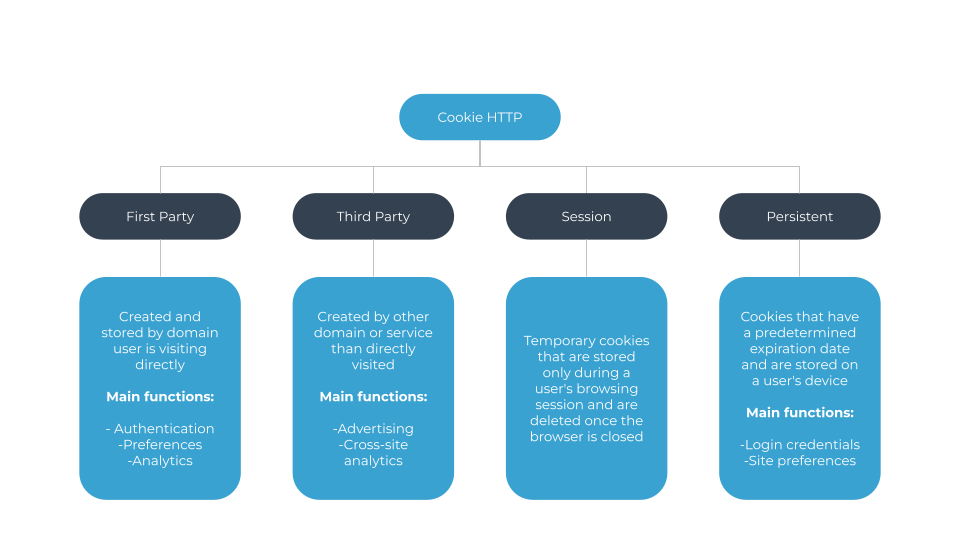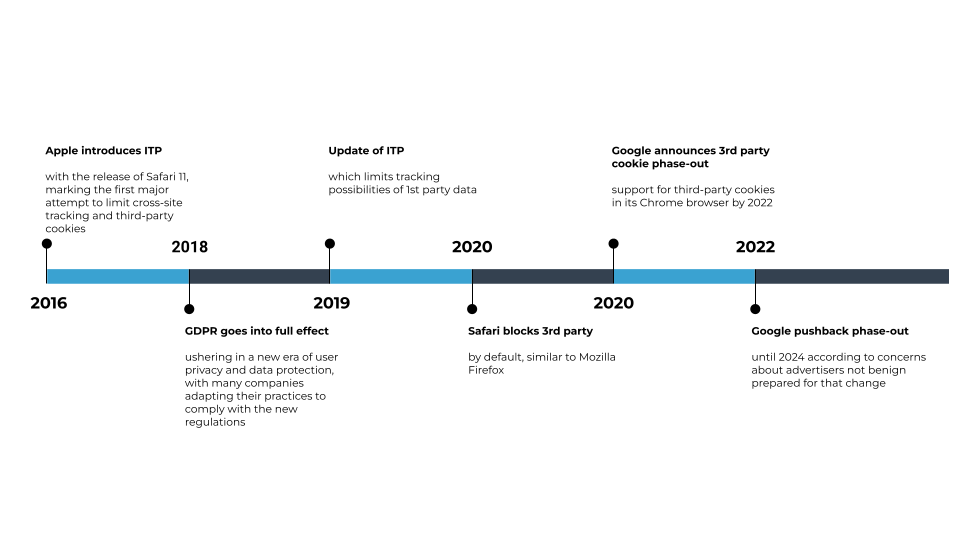December 7, 2023
by AdsLinkers
Share
Post-cookie era signifies a strategy aimed at engaging users while bypassing third-party cookies or alternative tracking mechanisms.
One significant drawback of cookies is their potential to intrude upon user privacy. Over the past few years, there has been a substantial industry-wide pivot away from the utilization of cookies. Notably, Google made an official declaration of ceasing third-party cookie usage on their Chrome browser. Their browser is commanding over 63% of the global market share (based on Statista data) – slated for completion by the mid of 2024.
Moreover, tech behemoth Apple revealed plans to modify Identifiers for Advertisers (IDFAs), enabling users to block these identifiers at the app level.
The imminent arrival of a cookieless era prompts the critical question: how should marketers and businesses ready themselves for this evolution? Let’s delve into this preparation process.
But what is a cookie?
In the digital domain, cookies refer to small text files that websites store on users’ devices. Their primary function revolves around enriching the user experience. These seemingly innocuous files serve to recall user preferences, authenticate user sessions, and gather crucial data for analytical purposes. By monitoring user behaviors and preferences, cookies empower websites to provide a more tailored, fluid browsing experience.
Types of cookies

Why is it important?
What does it mean for advertisers?
Focus on First-Party Data: As the transition from third-party cookies progresses, brands are increasingly prioritizing the collection and control of first-party data. This approach cultivates more direct and genuine connections with their clientele.
Privacy-Oriented Marketing: Embracing solutions and practices centered on privacy enables brands to showcase their dedication to data security. This builds trust and fosters loyalty within their customer base.
Drive for Innovation and Collaboration: The cookieless landscape sparks innovation within the marketing sphere, encouraging the industry to create new technologies and work together on privacy-conscious solutions. These advancements benefit both advertisers and consumers alike.
Solutions for post-cookie era
- Huge value of Contextual Marketing
- Gather first party data
- Focus on CRM data
- Use device unique IDs
Huge value of Contextual Marketing
In a cookieless marketing landscape, Contextual Marketing emerges as a formidable tool, gaining even more significance. This strategy predominantly revolves around personalized targeting, ensuring precise message delivery to the most fitting audience at optimal moments.
Contextual marketing thrives on three core elements: relevance, personalization, and precise targeting. Beyond adapting to a cookie-free environment, it stands poised to elevate conversion rates and fortify brand identity, presenting itself as an invaluable asset in navigating the evolving digital realm.
Gather first party data
First-party data, often referred to as 1P data, stands apart from third-party data due to its direct acquisition from your audience. It encompasses information gathered through various touchpoints like website registrations, lead generation, social media followers, email subscriptions, and customer surveys.
Essentially, any data collected directly from your customers falls under the purview of first-party data. This enables safe and strategic utilization of platforms such as Google Analytics, HubSpot, Salesforce, among others, for informed decision-making.
In contrast, the era of third-party data aggregation, where data was traded, is fading away. Access to browsing histories and external user behavior outside your own website will diminish, rendering third-party data collection obsolete in practice.
Focus on CRM data
Email communication has long been a cornerstone of marketing strategies and is poised to become even more pivotal. Building and nurturing an email list holds the key to expanding a business’s audience with genuinely interested users.
The significance lies in the voluntary provision of email addresses by individuals, signifying their explicit consent for future interactions. Moreover, email marketing serves as an invaluable avenue for fostering meaningful dialogue. It will be delivering exclusive offers, and tailoring user experiences for a more personalized approach.
Use device unique IDs
An effective strategy to gear up for the impending cookieless landscape involves leveraging device fingerprinting. This technology gathers comprehensive device details, including device model and number, system language or device orientation. Additionally operating systems, IP addresses, and browser information, constructing a distinctive fingerprint for each user.
While not flawless, this approach presents an opportunity for marketers seeking broad insights into user preferences, enabling a foundational understanding of consumer behavior.
Post-cookie timeline
The evolution of cookieless advertising has been profoundly influenced by mounting concerns surrounding user privacy and data safeguarding. Key milestones in this trajectory include the inception of the GDPR proposal in 2012, Apple’s implementation of Intelligent Tracking Prevention in 2016, followed by GDPR enforcement in 2018, the enactment of CCPA in 2019, and Google’s declaration of phasing out third-party cookies in 2020. As the industry navigates toward a cookieless environment, novel solutions such as FLoC and contextual targeting are under exploration. These innovations aim to sustain targeted advertising while upholding user privacy, reflecting a dynamic landscape continually adapting to evolving regulations and advancing technologies in response to escalating privacy apprehensions.

How AdsLinkers help post-cookie world?
In a cookieless world, AdsLinkers stands as a pivotal solution aiding businesses in adapting their marketing strategies. Leveraging contextual targeting, the platform empowers advertisers to craft precise campaigns aligned with users’ contextual behaviors and interests. Moreover, AdsLinkers enables seamless personalization of campaigns across external touchpoints, ensuring tailored content delivery without relying on individual user data. This approach enhances user engagement while upholding privacy standards. By optimizing contextual targeting and personalization, AdsLinkers significantly augments campaign efficiency, driving better engagement, conversion rates, and overall marketing performance in an era where traditional tracking methods are being phased out.
Conclusion
The evolution towards a cookieless marketing landscape has been driven by increasing concerns over user privacy and data protection. This transformative shift, marked by pivotal moments such as the introduction of GDPR, Apple’s Intelligent Tracking Prevention, and Google’s decision to phase out third-party cookies. It has compelled the industry to explore innovative alternatives like contextual targeting and device fingerprinting. Amidst these changes, AdsLinkers emerges as a comprehensive solution, embracing contextual targeting, personalization, and efficiency enhancements. By focusing on contextual cues and personalized campaigns that resonate across various touchpoints, AdsLinkers facilitates effective marketing strategies, ensuring tailored content delivery while respecting user privacy, setting a new standard for marketing success in the cookieless era.







